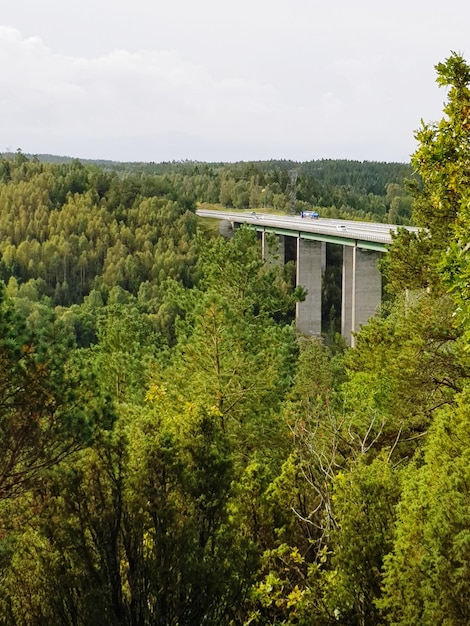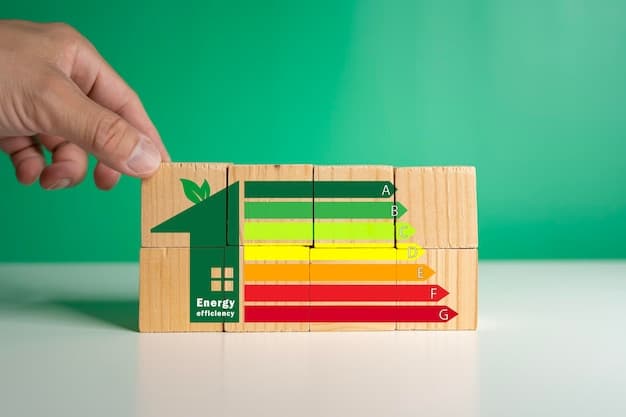CLT Construction: Unveiling the Environmental Benefits in the US

Cross-laminated timber (CLT) offers significant environmental benefits in US construction, including carbon sequestration, reduced greenhouse gas emissions, and sustainable forest management, making it a viable alternative to traditional materials like concrete and steel.
The US construction industry is constantly seeking sustainable alternatives to traditional building materials. What Are the Environmental Benefits of Using Cross-Laminated Timber (CLT) in US Construction Projects? Explore how this innovative material is revolutionizing the industry by offering a range of eco-friendly advantages.
Understanding Cross-Laminated Timber (CLT)
Cross-laminated timber (CLT) is an engineered wood product made by gluing together layers of solid-sawn lumber, each oriented perpendicular to adjacent layers. This creates a strong, dimensionally stable panel that can be used for walls, roofs, and floors. It’s increasingly being seen as a sustainable alternative to concrete and steel in construction projects.
What Makes CLT Different?
Unlike traditional wood framing, CLT’s cross-wise layering provides exceptional strength and stability. This allows for larger spans and taller structures, broadening the possibilities for wood construction.
The Manufacturing Process
The manufacturing process involves carefully selecting lumber, drying it to the appropriate moisture content, and then gluing the layers together under high pressure. The resulting panel is then cut to size and can be pre-fabricated off-site, reducing on-site construction time.
The environmental benefits of CLT start as early as the forest managment, and continued through the entire construction project:
- Sustainable Sourcing: CLT relies on timber sourced from sustainably managed forests, ensuring continuous growth and minimal environmental impact.
- Reduced Waste: Off-site pre-fabrication minimizes waste on construction sites, contributing to a leaner building process.
- Carbon Sequestration: As a wood product, CLT stores carbon absorbed by trees during their lifespan, effectively locking it away from the atmosphere.
CLT is a versatile and eco-conscious material, that can be applied in many different projects, reducing the environmental impact in the long run.
Carbon Sequestration and Storage
One of the most significant environmental benefits of using CLT is its ability to sequester and store carbon. Trees absorb carbon dioxide from the atmosphere during photosynthesis, and this carbon remains stored in the wood even after it’s harvested and used in construction.
The Role of Forests
Sustainably managed forests play a vital role in carbon sequestration. By ensuring continuous growth and responsible harvesting, these forests act as carbon sinks, absorbing more carbon than they release.

How CLT Stores Carbon
When CLT is used in construction, it effectively locks away the carbon stored in the wood for the lifespan of the building, preventing it from being released back into the atmosphere.
This makes CLT a great option to work towards a solution for carbon emissions:
- Long-Term Storage: Carbon remains stored in CLT structures for decades, contributing to long-term carbon reduction.
- Reduced Carbon Footprint: By using CLT, construction projects can significantly reduce their carbon footprint compared to using concrete or steel.
- Promoting Sustainable Forestry: The demand for CLT encourages sustainable forest management practices, further enhancing carbon sequestration efforts.
The carbon sequestration and storage capabilities of CLT can make a big impact in the long run, contributing to climate change mitigation.
Reduced Greenhouse Gas Emissions
Using CLT in construction also helps to reduce greenhouse gas emissions associated with the production and transportation of building materials. Concrete and steel production are energy-intensive processes that release significant amounts of greenhouse gases.
Lower Embodied Energy
CLT has a significantly lower embodied energy compared to concrete and steel. Embodied energy refers to the total energy required to extract, process, manufacture, and transport a material.
This reduction in greenhouse gas emissions also benefits the carbon footprint of construction projects by working towards a positive climate impact:
- Reduced Manufacturing Emissions: The manufacturing of CLT requires less energy and emits fewer greenhouse gases compared to concrete and steel.
- Lower Transportation Emissions: CLT is lighter than concrete and steel, reducing transportation emissions.
- Overall Carbon Footprint Reduction: By choosing CLT, construction projects can substantially lower their overall carbon footprint, contributing to environmental sustainability.
The lower embodied energy of CLT contributes to environmental sustainability and reduced carbon footprint of construction projects.

Sustainable Forest Management
The use of CLT promotes sustainable forest management practices in the US. Responsible forest management ensures that forests are harvested in a way that maintains their ecological integrity and long-term productivity.
Promoting Forest Health
Sustainable forest management practices help to promote forest health by preventing deforestation, protecting biodiversity, and ensuring that forests continue to provide valuable ecosystem services.
Responsible Harvesting
Responsible harvesting practices involve careful planning to minimize environmental impact, protecting water quality, and ensuring that forests can regenerate naturally or through reforestation efforts.
With those responsible practices in place, natural resources can flourish for many years:
- Certification Programs: Organizations like the Forest Stewardship Council (FSC) certify forests that meet strict sustainable management standards.
- Reforestation Efforts: After harvesting, reforestation efforts ensure that new trees are planted to replace those that were harvested, maintaining forest cover and carbon sequestration capacity.
- Long-Term Productivity: Sustainable forest management ensures that forests remain productive and healthy for future generations.
Sustainable forest management practices are esential to ensure wood resources for future use for the CLT construction, without damaging the ecosystem.
Waste Reduction in Construction
CLT can help to reduce waste in construction projects through pre-fabrication and efficient material use. Pre-fabrication involves manufacturing building components off-site in a controlled factory environment.
Off-Site Pre-fabrication
Off-site pre-fabrication allows for greater precision and reduces the amount of waste generated on the construction site. Components are manufactured to exact specifications, minimizing the need for on-site adjustments and cutting.
Material waste is a common issue in construction projects, and CLT aims to solve that by:
- Reduced On-Site Waste: By pre-fabricating components off-site, the amount of waste generated on the construction site is significantly reduced.
- Efficient Material Use: CLT panels are engineered to optimize material use, minimizing waste during manufacturing.
- Cost Savings: Reducing waste translates to cost savings for construction projects, making CLT a more economical option.
Reducing waste in costruction is important to lower the impact during the construction project, and CLT can achieve that.
Life Cycle Assessment Benefits
A life cycle assessment (LCA) is a comprehensive analysis of the environmental impacts associated with a product or service throughout its entire life cycle, from raw material extraction to disposal. LCAs of CLT construction demonstrate its environmental advantages over traditional materials.
Lower Environmental Impact
LCAs consistently show that CLT has a lower environmental impact than concrete and steel across a range of indicators, including greenhouse gas emissions, energy consumption, and water use.
Life cycle assessments provide the proper tools to truly understand the long-term impact of CLT buildings:
- Comprehensive Analysis: LCA considers all stages of a building’s life cycle, providing a holistic view of its environmental impact.
- Data-Driven Decision Making: LCA provides data-driven insights that can inform decision-making and help to identify opportunities for improvement.
- Promoting Transparency: By conducting LCAs, construction projects can promote transparency and accountability in their environmental performance.
By understanding the long term impacts and benefits, architects and developers can make even better sustainability choices.
| Key Point | Brief Description |
|---|---|
| 🌳 Carbon Sequestration | CLT stores carbon absorbed by trees, reducing atmospheric CO2. |
| 🏭 Reduced Emissions | Lower embodied energy leads to less pollution than concrete/steel. |
| 🌲 Sustainable Forests | Promotes responsible forest management and reforestation efforts. |
| 🗑️ Waste Reduction | Pre-fabrication minimizes on-site construction waste. |
Frequently Asked Questions (FAQs)
With proper maintenance, CLT buildings can last as long as conventional concrete or steel structures, often exceeding 100 years. Durability depends on design and protection from moisture.
Yes, CLT has excellent fire resistance. The outer layers char during a fire, which slows down combustion and protects the inner layers, maintaining structural integrity longer.
The cost of CLT can be competitive with steel, especially when considering reduced construction time and lower labor costs. Prices vary by project and location.
Yes, advancements in CLT technology and building codes allow for its use in high-rise buildings. Several tall wood structures have been successfully built worldwide, demonstrating its potential.
CLT is sourced from sustainably managed forests across the US, particularly in the Pacific Northwest and Southeast, where timber resources are abundant and well-regulated.
Conclusion
Embracing cross-laminated timber in US construction projects offers a multitude of environmental advantages, from its carbon sequestration capabilities to reduced greenhouse gas emissions and promotion of sustainable forest management. As the construction industry continues to prioritize sustainability, CLT stands out as a promising solution for creating greener, more eco-friendly buildings.





